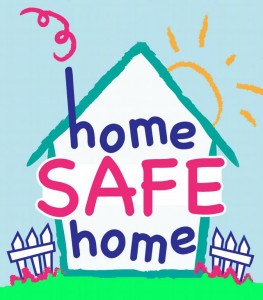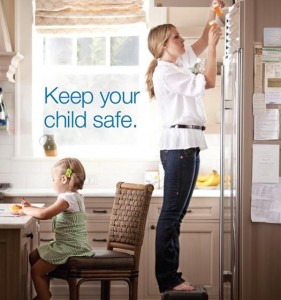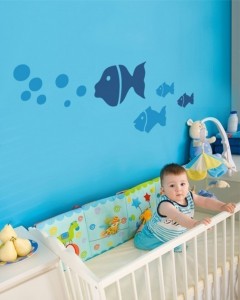25 tips to make your house a happy and healthy safe haven.
When you’ve got a young child, you’ve got a little adventurer on your hands, always keen to examine every nook and cranny, and to touch and taste everything he can get his hand on! But while this eagerness to explore can be great for his learning and development, it can also get him into some sticky s ituations. According to the Royal Children’s Hospital Melbourne, little ones from birth to fourth years account for over half hospital patients treated for accidents in the home. Burns, bumps and falls, poisoning, chocking and near-drowning are among the top type of accidents kids can encounter – but thankfully there’s a lot that you can do to prevent them. The first step when it comes to making your home kid-safe? “Get down on your hands and knees and pretend to be a child to see what kinds of mischief you might get into”, advises Christine, executive officer of Kidsafe NSW. “Until you’re down thee you don’t notice the power points, the sharp corners, the cupboard doors or the dangling vertical-blind cords”.
ituations. According to the Royal Children’s Hospital Melbourne, little ones from birth to fourth years account for over half hospital patients treated for accidents in the home. Burns, bumps and falls, poisoning, chocking and near-drowning are among the top type of accidents kids can encounter – but thankfully there’s a lot that you can do to prevent them. The first step when it comes to making your home kid-safe? “Get down on your hands and knees and pretend to be a child to see what kinds of mischief you might get into”, advises Christine, executive officer of Kidsafe NSW. “Until you’re down thee you don’t notice the power points, the sharp corners, the cupboard doors or the dangling vertical-blind cords”.
Here are tips that you and your au pair can follow for keeping your child as safe as can be…
Home Hints In The Kitchen
1. Be food safe. The re are 5.4 million cases of food-borne illness in Australia each year, and kids are particularly vulnerable. The bacteria that cause food poisoning like to grow between 5° and 60°C, so keep hot food piping hot and store cold food at 4°C or below. Keep ready-to-eat and raw food separate during preparation and storage, wash hand before and after handling food, pay attention to use-by dates and be sure to cook meats thoroughly.
re are 5.4 million cases of food-borne illness in Australia each year, and kids are particularly vulnerable. The bacteria that cause food poisoning like to grow between 5° and 60°C, so keep hot food piping hot and store cold food at 4°C or below. Keep ready-to-eat and raw food separate during preparation and storage, wash hand before and after handling food, pay attention to use-by dates and be sure to cook meats thoroughly.
2. Keep it clean. If you have an au pair tell her to wipe down all kitchen surfaces as you go, particularly where raw foods have been prepared, to help limit of spread of bacteria. It’s best to have one sponge or cloth for surfaces and another for dishes and to change these regularly. Pop them, wet, in the microwave for a couple of minutes to help zap the bugs.
3. Put things on the back burner. “Since there are so many hot things in the kitchen, it can be a pretty dangerous place”, Christine notes. To prevent accidents, put pots and pans on the back burner or turn the handless away to stop your little one reaching for them. “Children around nine to 15 months ae starting to pull themselves up and may grab for these. They might also use the hot oven door”, Christine says, adding that stove guards can be a good investment for this reason.
4. Look it up. Installing childproof locks, latches or brands on cupboards and drawers in the kitchen, is an important safety measure. This can stop your child from using drawers to climb to dangerous heights, from getting his hands on sharp utensils and household chemicals such as detergents, and helps keep other items, such as plastic bags, out of harm’s way.
5. Bring out the barriers. “If you can, keep your child out of the kitchen all together with a gate or barrier”, Christine advises. If you need to spend time in the kitchen, keep him quietly occupied with crafts in your line of sight, or find something for him to do in another area of the house that’s close by.
Home Hints In The Living Room
6. Bet on barriers. “It’s important to use a barrier or gate to prevent younger children from going up and down any stairs,” Christine says, as topples and tumbles are very real risks. ”When it comes to the balustrades, make sure your child can’t get stuck between the rails, can’t climb on them or slip under through them”, she adds.
7. Be on dirt alert. When you have time to get on top of household chores, try to vacuum carpets and wash floorboards, as little kid get really up close and personal with these surfaces! Watch your use of harsh cleaning agents that might leave chemical residues, and think about a “no shoes” policy for your house – it’s a great way to keep (or at least limit) dirt, muck and pollutants from getting in.
8. Show socket safety. All unused power point and strips should be blocked with power-point covers, Christine advises, which will stop you littlie from poking thing into them. Having safety switches installed that switch the power off if there is a fault can also help prevent electrical shocks.
9. Go on lockdown. Climbing and clambering kids get hurt from toppling furniture or other items, says Christine. Make sure furniture is sturdy and not-top-heavy to limit the chances of toppling, and secure items to the wall with ‘L’ brackets where you can. Also watch heavy objects on top of furniture that could easily fall onto your child – secure the TV with a strap, keep big or breakable objects in cabinets and try to avoid decorative tablecloths or other dangling items that could be pulled on to send items falling.
10. Be (smoke) alarmed. Smoke alarms are an important measure in keeping the whole family safe. Have them installed on every level of your home, particularly near the bedrooms, and be sure to test them regularly and change the batteries often.
Home Hints In The Bedrooms
11. Change the bed. If y our toddler is still in his cot, he may develop a habit of climbing up and over the cot rails when he wants to get out, which can lead to falls. While there’s no set age for making the transition from cot to big bed, most kids are ready around the age of two. It’s a good idea to choose a bed with small side rails to stop him from rolling out of it.
our toddler is still in his cot, he may develop a habit of climbing up and over the cot rails when he wants to get out, which can lead to falls. While there’s no set age for making the transition from cot to big bed, most kids are ready around the age of two. It’s a good idea to choose a bed with small side rails to stop him from rolling out of it.
12. Careful of cords! As the Child Safety Handbook published by the Royal Children’s Hospital Melbourne notes, dangling curtain cords, phone cords and straps, ties and strings on clothes and toys can pose a strangulation risk. When it comes to window cords, these should be kept shorter than 30 cm and well off the floor. If you can’t cut or exchange window cords for rods, secure them with a cord clips or wrap them around a cleat, and keep your child’s cot or bed well away from them.
13. Have high standards. Particularly if you’re getting it second-hand from eBay, friends or the op-shop, make sure all furniture meets current Australian Safety Standards.
14. Watch windows. “Children can fall out of a window which is open more than 10 cm, even if a fly screen is present”, the Children’s Hospital at Westmead warns. As part of its “Kids Can’t Fly” campaign, the hospital recommends all windows have locks fitted to stop them being opened more than 10 cm, or have window guards installed. Also watch where you position cots, beds and objects kids can clamber on top of in relation to windows.
15. Play safely. When it comes to storing toys, your littlie’s toy chest should have lid support so it doesn’t slam shut on his tiny fingers and ventilation holes should be climb on in a find himself stuck. The toys themselves should have no small, sharp or breakable parts. Follow the age recommendations and check regularly for wear and tear.
Home Hints In The Bathroom
16. Simmer down. The Child Safety Handbook notes that “the best way of preventing scalds in the bathroom is to reduce the temperature of the hot tap water at the basin, bath and shower to 50°C”. Tap covers that stop tots from turning taps on and off are another good idea. Make sure that your au pair is careful when she puts the kids in the shower.
17. Be mindful with medicines. Keep medicines in a child-proof box in a cabinet at least 1.5m off the ground so they’re out of reach and out of sight of curious hands and mouths. While you’re at it, lock away mouthwash, nail polish remover, hair dye and the like, along with sharp objects such as nail scissors and razor blades.
18. Wash well! Hand-washing is so important! Little kids often fall sick when faecal bacteria end up in their mouths, so teach your littlie how to wash his hands well after using the toilet, touching pets and being out and about. Hands should always be scrubbed well before eating, too.
19. Don’t slip ‘n’ side. “The bathroom is a wet, slippery place with lots of hard surfaces and slips and trips can happened for adults as well as children”, Christine warns. She suggests using non-slip mats and to plan, plan, plan. “Bathtime is an event, so you need a little ‘event management’! Have the towels ready, something to mop up splashes and clothes nearby”
20. Be on water watch. Supervision in the bath is paramount. Ignore phone calls and stuff going on in other rooms of the house when your tyke is in the tub – she should never be left unattended. Toilet water can also prove problematic, so keep the lid closed and consider a child-proof latch.
Home Hints In The Yard
21. Put it away! The Royal  Children’s Hospital Melbourne reports that a third of home injuries to children under five years occur in the garden or garage. A good first step in preventing accidents is to securely lock away tools, ladders, gardening instruments and other such gear so that your child can’t get to them.
Children’s Hospital Melbourne reports that a third of home injuries to children under five years occur in the garden or garage. A good first step in preventing accidents is to securely lock away tools, ladders, gardening instruments and other such gear so that your child can’t get to them.
22. Be sensible with poisons. As well as storing these correctly (in their original containers, well away from your child’s sight and reach), use them wisely. Snail pellets shouldn’t be used in the garden, for example, as your child or pet might mistake them for a snack. And if you’ve had to use any pesticides, herbicides or other chemicals, don’t let your littlie out there to roll in them.
23. Weed out nasty plants. Some plants are poisonous if eaten or prone to causing irritation when touched, so be careful what you let grow. “On our Kidsafe website, www.kidsafensw.org, we have information about what plants to avoid and your local council will also have this information”, says Christine.
24. Avoid driveway accidents. It’s a scary statistic – according to Kidsafe, one child is run over in the driveway of their home each week in Australia. Always have someone (like an au pair) holding your child’s hand or holding close when the car is being moved in or out of the driveway. It’s also wise to discourage playing near the driveway and to make access to it difficult with fencing or gates.
25. Be water wise. All pools and spas should be surrounded by a well-maintained fence with a self-locking gate, and even inflatable pools that exceed 30cm need a barrier around them, too. It’s best to empty, deflate and store these safely when not in use to prevent water puddling in them, Christine reminds. “Also be careful of pet bowls, bucket and other containers that may be able to fill with water when it rains. Little children are very top heavy and can drown in very small amount of water”.